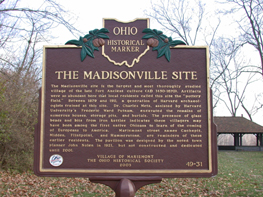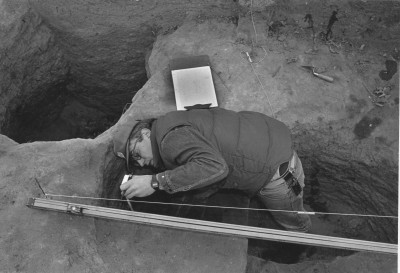 The land now known as the Madisonville Site (in Dogwood Park near the Mariemont Swimming Pool) was the location of a thriving village of Native Americans, one of the last groups to occupy territory in this area. The settlement existed from about 1400-1650, and covered the southwest corner of Mariemont. Estimates place the population at 250-300 people at its peak.
The land now known as the Madisonville Site (in Dogwood Park near the Mariemont Swimming Pool) was the location of a thriving village of Native Americans, one of the last groups to occupy territory in this area. The settlement existed from about 1400-1650, and covered the southwest corner of Mariemont. Estimates place the population at 250-300 people at its peak.
The site had long been abandoned by the time European settlers reached our area in 1788. Since there was no contact between the prehistoric group and English-speaking pioneers, we know very little about the people who lived here for so many years. What we do know about their way of life has come to us through a series of archaeological digs at the Madisonville Site.
There is evidence that people have been poking around the site, trying to grab a piece of the past, since the 1850’s. Certainly, “Potter’s Field” was well known to local residents in 1879, when it drew the attention of Dr. Charles Metz, a Madisonville resident, physician, and avid archaeologist. The name of the site derives from Dr. Metz’ close connection to Madisonville, and the fact that it was the closest town at the time the Indian village was uncovered. The owner of the property, Miss Phebe Ferris, granted Metz permission to begin a scientific excavation on her land, as she too was curious about what might be found. The initial work lasted for over 30 years (1878-1911).
Artifacts continued to be discovered long after the excavations ended. In 1923, as construction of the new town of Mariemont was beginning, an engineer reported finding a skeleton adorned with copper disks and beads. For decades, local residents and amateur archaeologists continued to dig and remove objects. Some are in private collections, but many have been lost. In 1980, the Village passed an ordinance that prohibited further digging without permission. Interest in the site remained, however, and Village officials wanted to find out how much of value remained.
In 1987, the Village issued a permit to Dr. C. Wesley Cowan (pictured) to conduct a “short” exploration of the area. Immediately, an incredible wealth of artifacts began to emerge. The 20th cent ury team had several advantages over their predecessors who were led by Dr. Metz. Advances in photography and radio carbon dating greatly aided the modern scientists in interpreting their finds, as did much greater precision in mapping and field notes.
ury team had several advantages over their predecessors who were led by Dr. Metz. Advances in photography and radio carbon dating greatly aided the modern scientists in interpreting their finds, as did much greater precision in mapping and field notes.
Combined with the work done earlier, a picture of life at the Madisonville Site has emerged. Postholes indicate a grouping of dwellings with a central plaza. Pottery pieces place the group in the Late Fort Ancient period. We do not know if the tribe was part of a larger group of Native Americans that perhaps are still in existence today, such as the Shawnee, but DNA tests are underway to see if a connection can be found. Skeletal remains were unearthed that had been buried with ornamentation and with pottery placed at the shoulders of the deceased. There is no evidence of direct contact by these Late Fort Ancient people and the arriving settlers. One or two artifacts of metal have been found, but were probably acquired through trading with other tribes. The Mariemont Preservation Foundation has a collection of artifacts (available for viewing on Saturdays) that includes musical instruments made of bone, bone jewelry, stone and bone tools, arrowheads, a bear tooth, and much more. Items from the Site are housed in museums all over the world, including the Smithsonian Institution, The Peabody Museum (Harvard University) and the Wanganui Museum in New Zealand, to name a few. The Madisonville Site is considered to be of great importance in the history of the indigenous peoples of the Ohio River Valley.
Last modified: January 21, 2024
